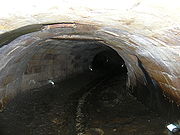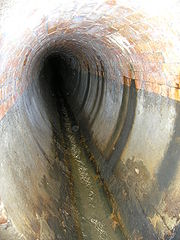
Tank Stream
Encyclopedia

Sydney Cove
Sydney Cove is a small bay on the southern shore of Port Jackson , on the coast of the state of New South Wales, Australia....
in New South Wales
New South Wales
New South Wales is a state of :Australia, located in the east of the country. It is bordered by Queensland, Victoria and South Australia to the north, south and west respectively. To the east, the state is bordered by the Tasman Sea, which forms part of the Pacific Ocean. New South Wales...
, Australia
Australia
Australia , officially the Commonwealth of Australia, is a country in the Southern Hemisphere comprising the mainland of the Australian continent, the island of Tasmania, and numerous smaller islands in the Indian and Pacific Oceans. It is the world's sixth-largest country by total area...
. Today it is little more than a storm water drain, but originally it was the fresh water supply for the fledgling colony of New South Wales in the late 18th century. It originated from a swamp to the west of present day Hyde Park
Hyde Park, Sydney
Hyde Park is a large park in Sydney, New South Wales, Australia. Hyde Park is on the eastern side of the Sydney central business district. It is the southernmost of a chain of parkland that extends north to the shore of Port Jackson . It is approximately rectangular in shape, being squared at the...
and at high tide entered Sydney Cove at the intersection of Bridge
Bridge Street, Sydney
Bridge Street is a street in the CBD of Sydney, Australia. It runs east-west between George Street and Macquarie Street. It is in the Local Government Area of the City of Sydney and the postcode is 2000. The street is 500 metres long...
and Pitt Street
Pitt Street, Sydney
Pitt Street is a major street in central Sydney, New South Wales, Australia. The street runs through the entire city centre from Circular Quay in the north to Waterloo, although today's street is in two disjointed sections after a substantial stretch of it was removed to make way for Sydney's...
s. The catchment was 65 hectares (161 acre), corresponding roughly the size of the Sydney central business district
Sydney central business district
The Sydney central business district is the main commercial centre of Sydney, New South Wales, Australia. It extends southwards for about 3 kilometres from Sydney Cove, the point of first European settlement. Its north–south axis runs from Circular Quay in the north to Central railway station in...
.
History

Indigenous Australians
Indigenous Australians are the original inhabitants of the Australian continent and nearby islands. The Aboriginal Indigenous Australians migrated from the Indian continent around 75,000 to 100,000 years ago....
flake stone artifacts made from water-worn pebbles. The stream gave the aborigines fresh water, fish and other resources. The area was chosen by First Fleet
First Fleet
The First Fleet is the name given to the eleven ships which sailed from Great Britain on 13 May 1787 with about 1,487 people, including 778 convicts , to establish the first European colony in Australia, in the region which Captain Cook had named New South Wales. The fleet was led by Captain ...
Captain Arthur Phillip
Arthur Phillip
Admiral Arthur Phillip RN was a British admiral and colonial administrator. Phillip was appointed Governor of New South Wales, the first European colony on the Australian continent, and was the founder of the settlement which is now the city of Sydney.-Early life and naval career:Arthur Phillip...
in 1788 as the location for the New South Wales colony for similar reasons.
The colony had originally been planned for Botany Bay
Botany Bay
Botany Bay is a bay in Sydney, New South Wales, a few kilometres south of the Sydney central business district. The Cooks River and the Georges River are the two major tributaries that flow into the bay...
, on the recommendation of Sir Joseph Banks who had visited the area with Captain James Cook 17 years earlier, but when no fresh water was found there, Phillip sought a better site, and found it in the previously unvisited Port Jackson
Port Jackson
Port Jackson, containing Sydney Harbour, is the natural harbour of Sydney, Australia. It is known for its beauty, and in particular, as the location of the Sydney Opera House and Sydney Harbour Bridge...
. Sydney Cove was chosen for settlement as it "was at the head of the cove, near the run of fresh water which stole silently along through a very thick wood". On January 26, 1788 the new colony was inaugurated.
During a drought in 1790 three storage tanks were constructed in the sandstone beside the Tank Stream and it is from these that the stream gets its name. The Tank Stream could not meet the needs of the growing colony. It was abandoned in 1826, though it had been little more than an open sewer for the preceding two decades. Sydney's next supply of water was Busby's Bore
Busby's Bore
Busby's Bore was Sydney's second water supply. It was built by convict labour and completed in 1830.-History:By the 1820s, the Tank Stream, Sydney's original water supply, was in dire straits...
, in 1830.
In 1850 the swamp feeding the Tank Stream was drained. Starting in 1860, the Tank Stream was progressively covered and is now a storm water channel which is controlled by Sydney Water
Sydney Water
Sydney Water is a New South Wales government owned corporation that provides drinking water, wastewater and some stormwater services to Sydney, Illawarra and the Blue Mountains, in Australia...
. Recently there have been calls from some to see it run above ground again to create a central feature in the city.
Tourism
Tank Stream tours are run by the Historic Houses Trust and Sydney Water. These are usually in April and November. The tickets are limited, doled by ballot. There's an information centre behind locked gates at the beginning of the tour. One can also trace the previous stream course following art work, street names, and pub names.External links
- The Tank Stream - Creative Spirits

